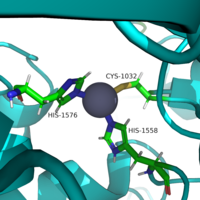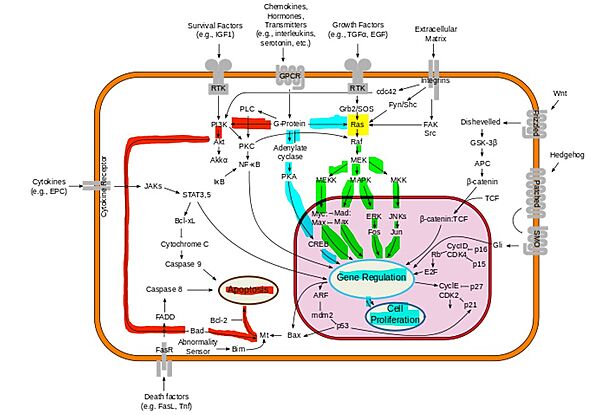Neurofibromin
From Proteopedia
(Difference between revisions)
| Line 1: | Line 1: | ||
<StructureSection load='' scene='90/904325/Introductory_image_full/2' size='340' side='right' caption='Neurofibromin [https://www.rcsb.org/structure/7PGS (7pgs)] Homo dimeric structure colored to differentiate dimers'> | <StructureSection load='' scene='90/904325/Introductory_image_full/2' size='340' side='right' caption='Neurofibromin [https://www.rcsb.org/structure/7PGS (7pgs)] Homo dimeric structure colored to differentiate dimers'> | ||
== Introduction == | == Introduction == | ||
| - | <scene name='90/904325/Introductory_image_full/1'>Neurofibromin</scene> (NF) is a cytoplasmic protein encoded by the ''NF1'' gene located on chromosome 17 <ref name= "Bergoug">PMID:33121128</ref>. It is localized to the cell membrane by the [https://en.wikipedia.org/wiki/SPRED1 SPRED 1] protein<ref name= "Naschberger">PMID:34707296</ref>. The neurofibromin protein in encoded by over 350 kb of DNA and contains 62 exons, 58 of which are constitutive<ref name= ''Trovó-Marqui''>PMID:16813595</ref>. NF suppresses the <scene name='90/904325/Ras_neurofibromin_overview/1'>Ras</scene> oncogene by increasing the rate of hydrolysis from <scene name='90/904325/Arginine_finger_and_gtp/3'>Ras bound to GTP</scene> (active) to <scene name='90/904325/Arginine_finger_and_gdp/4'>Ras bound to GDP</scene> (inactive)<ref name= ''Hall''>PMID:12213964</ref>. Increasing the rate of Ras inactivation decreases cell proliferation linked to cancer<ref name= | + | <scene name='90/904325/Introductory_image_full/1'>Neurofibromin</scene> (NF) is a cytoplasmic protein encoded by the ''NF1'' gene located on chromosome 17 <ref name= "Bergoug">PMID:33121128</ref>. It is localized to the cell membrane by the [https://en.wikipedia.org/wiki/SPRED1 SPRED 1] protein<ref name= "Naschberger">PMID:34707296</ref>. The neurofibromin protein in encoded by over 350 kb of DNA and contains 62 exons, 58 of which are constitutive<ref name= ''Trovó-Marqui''>PMID:16813595</ref>. NF suppresses the <scene name='90/904325/Ras_neurofibromin_overview/1'>Ras</scene> oncogene by increasing the rate of hydrolysis from <scene name='90/904325/Arginine_finger_and_gtp/3'>Ras bound to GTP</scene> (active) to <scene name='90/904325/Arginine_finger_and_gdp/4'>Ras bound to GDP</scene> (inactive)<ref name= ''Hall''>PMID:12213964</ref>. Increasing the rate of Ras inactivation decreases cell proliferation linked to cancer<ref name= "Cimino">PMID:29478615</ref>. |
== Structure == | == Structure == | ||
Neurofibromin is a large protein of 2818 amino acids <ref name="Bergoug"/> and is a homodimer that exists in two conformations. | Neurofibromin is a large protein of 2818 amino acids <ref name="Bergoug"/> and is a homodimer that exists in two conformations. | ||
| Line 32: | Line 32: | ||
== Disease Relevance == | == Disease Relevance == | ||
| - | Mutations to the neurofibromin protein are implicated in the progression of Neurofibromatosis type 1. Neurofibromatosis type 1 is a condition where cancer develops by inactivating the Ras suppression effects of NF, allowing Ras to behave as an oncogene. Neurofibromatosis type 1 is an autosomal dominant disorder that affects 1 in 3,000 people. The ''NF'' gene has the highest mutation rate of any human gene, adding to the prevalence of cancers related to neurofibromin mutations<ref name= "Lupton"/>. Furthermore, these mutations consist heavily of [https://en.wikipedia.org/wiki/Mutation#By_inheritance ''de novo''] mutations<ref name= ''Abramowicz''>PMID:25182393</ref>. NF1 primarily causes tumors in the [https://en.wikipedia.org/wiki/Central_nervous_system_disease#Structural_defects central] and peripheral nervous systems, but often has a multisystem expression including tumors in the dermatologic, cardiovascular, gastrointestinal, and orthopedic systems<ref name= | + | Mutations to the neurofibromin protein are implicated in the progression of Neurofibromatosis type 1. Neurofibromatosis type 1 is a condition where cancer develops by inactivating the Ras suppression effects of NF, allowing Ras to behave as an oncogene. Neurofibromatosis type 1 is an autosomal dominant disorder that affects 1 in 3,000 people. The ''NF'' gene has the highest mutation rate of any human gene, adding to the prevalence of cancers related to neurofibromin mutations<ref name= "Lupton"/>. Furthermore, these mutations consist heavily of [https://en.wikipedia.org/wiki/Mutation#By_inheritance ''de novo''] mutations<ref name= ''Abramowicz''>PMID:25182393</ref>. NF1 primarily causes tumors in the [https://en.wikipedia.org/wiki/Central_nervous_system_disease#Structural_defects central] and peripheral nervous systems, but often has a multisystem expression including tumors in the dermatologic, cardiovascular, gastrointestinal, and orthopedic systems <ref name="Cimino"/>. The wide range of presentations is consistent with the multiplicity of mutations observed in the causative protein<ref name= ''Ly''>PMID:31582003</ref>. This multiplicity derives from the immense size and homo dimeric nature of the neurofibromin protein that allows for otherwise innocuous mutations to wreak havoc on the conformations of the protein as well as its ability to bind to the Ras protein given that the positioning of NF relative to Ras is highly important. |
==Downstream Effects== | ==Downstream Effects== | ||
Revision as of 17:09, 21 April 2022
| |||||||||||
References
- ↑ 1.0 1.1 Bergoug M, Doudeau M, Godin F, Mosrin C, Vallee B, Benedetti H. Neurofibromin Structure, Functions and Regulation. Cells. 2020 Oct 27;9(11). pii: cells9112365. doi: 10.3390/cells9112365. PMID:33121128 doi:http://dx.doi.org/10.3390/cells9112365
- ↑ 2.0 2.1 2.2 2.3 2.4 2.5 Naschberger A, Baradaran R, Rupp B, Carroni M. The structure of neurofibromin isoform 2 reveals different functional states. Nature. 2021 Nov;599(7884):315-319. doi: 10.1038/s41586-021-04024-x. Epub 2021, Oct 27. PMID:34707296 doi:http://dx.doi.org/10.1038/s41586-021-04024-x
- ↑ Trovo-Marqui AB, Tajara EH. Neurofibromin: a general outlook. Clin Genet. 2006 Jul;70(1):1-13. doi: 10.1111/j.1399-0004.2006.00639.x. PMID:16813595 doi:http://dx.doi.org/10.1111/j.1399-0004.2006.00639.x
- ↑ Hall BE, Bar-Sagi D, Nassar N. The structural basis for the transition from Ras-GTP to Ras-GDP. Proc Natl Acad Sci U S A. 2002 Sep 17;99(19):12138-42. Epub 2002 Sep 4. PMID:12213964 doi:http://dx.doi.org/10.1073/pnas.192453199
- ↑ 5.0 5.1 Cimino PJ, Gutmann DH. Neurofibromatosis type 1. Handb Clin Neurol. 2018;148:799-811. doi: 10.1016/B978-0-444-64076-5.00051-X. PMID:29478615 doi:http://dx.doi.org/10.1016/B978-0-444-64076-5.00051-X
- ↑ Yoshimura SH, Hirano T. HEAT repeats - versatile arrays of amphiphilic helices working in crowded environments? J Cell Sci. 2016 Nov 1;129(21):3963-3970. doi: 10.1242/jcs.185710. Epub 2016 Oct , 6. PMID:27802131 doi:http://dx.doi.org/10.1242/jcs.185710
- ↑ 7.0 7.1 7.2 Lupton CJ, Bayly-Jones C, D'Andrea L, Huang C, Schittenhelm RB, Venugopal H, Whisstock JC, Halls ML, Ellisdon AM. The cryo-EM structure of the human neurofibromin dimer reveals the molecular basis for neurofibromatosis type 1. Nat Struct Mol Biol. 2021 Dec;28(12):982-988. doi: 10.1038/s41594-021-00687-2., Epub 2021 Dec 9. PMID:34887559 doi:http://dx.doi.org/10.1038/s41594-021-00687-2
- ↑ Scheffzek K, Welti S. Pleckstrin homology (PH) like domains - versatile modules in protein-protein interaction platforms. FEBS Lett. 2012 Aug 14;586(17):2662-73. doi: 10.1016/j.febslet.2012.06.006. Epub , 2012 Jun 19. PMID:22728242 doi:http://dx.doi.org/10.1016/j.febslet.2012.06.006
- ↑ Dunzendorfer-Matt T, Mercado EL, Maly K, McCormick F, Scheffzek K. The neurofibromin recruitment factor Spred1 binds to the GAP related domain without affecting Ras inactivation. Proc Natl Acad Sci U S A. 2016 Jul 5;113(27):7497-502. doi:, 10.1073/pnas.1607298113. Epub 2016 Jun 16. PMID:27313208 doi:http://dx.doi.org/10.1073/pnas.1607298113
- ↑ Frech M, Darden TA, Pedersen LG, Foley CK, Charifson PS, Anderson MW, Wittinghofer A. Role of glutamine-61 in the hydrolysis of GTP by p21H-ras: an experimental and theoretical study. Biochemistry. 1994 Mar 22;33(11):3237-44. doi: 10.1021/bi00177a014. PMID:8136358 doi:http://dx.doi.org/10.1021/bi00177a014
- ↑ Bunda S, Burrell K, Heir P, Zeng L, Alamsahebpour A, Kano Y, Raught B, Zhang ZY, Zadeh G, Ohh M. Inhibition of SHP2-mediated dephosphorylation of Ras suppresses oncogenesis. Nat Commun. 2015 Nov 30;6:8859. doi: 10.1038/ncomms9859. PMID:26617336 doi:http://dx.doi.org/10.1038/ncomms9859
- ↑ Abramowicz A, Gos M. Neurofibromin in neurofibromatosis type 1 - mutations in NF1gene as a cause of disease. Dev Period Med. 2014 Jul-Sep;18(3):297-306. PMID:25182393
- ↑ Ly KI, Blakeley JO. The Diagnosis and Management of Neurofibromatosis Type 1. Med Clin North Am. 2019 Nov;103(6):1035-1054. doi: 10.1016/j.mcna.2019.07.004. PMID:31582003 doi:http://dx.doi.org/10.1016/j.mcna.2019.07.004
- ↑ McCubrey JA, Steelman LS, Chappell WH, Abrams SL, Wong EW, Chang F, Lehmann B, Terrian DM, Milella M, Tafuri A, Stivala F, Libra M, Basecke J, Evangelisti C, Martelli AM, Franklin RA. Roles of the Raf/MEK/ERK pathway in cell growth, malignant transformation and drug resistance. Biochim Biophys Acta. 2007 Aug;1773(8):1263-84. doi:, 10.1016/j.bbamcr.2006.10.001. Epub 2006 Oct 7. PMID:17126425 doi:http://dx.doi.org/10.1016/j.bbamcr.2006.10.001
Proteopedia Page Contributors and Editors (what is this?)
Jordyn K. Lenard, Ryan D. Adkins, Michal Harel, OCA, Jaime Prilusky



